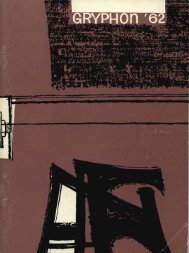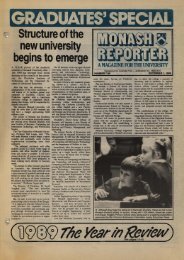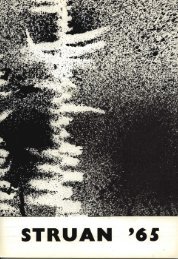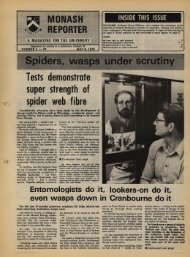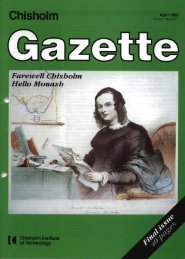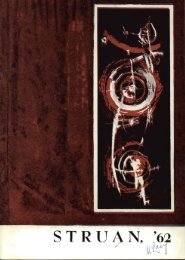GAZETTE - Adm.monash.edu.au - Monash University
GAZETTE - Adm.monash.edu.au - Monash University
GAZETTE - Adm.monash.edu.au - Monash University
- No tags were found...
You also want an ePaper? Increase the reach of your titles
YUMPU automatically turns print PDFs into web optimized ePapers that Google loves.
trained to eat the kind of food that is to be used. Thenthe <strong>au</strong>tomatic dispenser is placed over the tank andcontrolled by the experimenter who releases a few grainsof food each time the fish swims near. Soon the fishcomes over to the dispenser when hungry and waits forfood to come out. The next step is to connect thedispenser to the paddle switch which is lowered into thewater with a piece of the same food firmly stuck to it.The fish attacks the paddle to take the food and thedispenser <strong>au</strong>tomatically drops a few grains down fromabove. Before long he is pushing the paddle to operatethe dispenser and once this stage is reached discriminationtraining can begin. The paddle is now placed nearthe side of the tank and a miniature slide projectormounted outside so that the slides are seen from insidethe tank through the transparent paddle. One or two ofthese units can be used together (Fig. 3). Automaticequipment selects the stimulus pattern to be presentedand switches connections between the paddle and thereward dispenser so that only one pattern is consistentlyligence can be tested and compared with those of otheranimals placed in similar situations. Differences canthen be correlated with differences in brain structureand so theories of the function of various parts of thebrain can be put lip for experimental test. Secondly,knowing the normal performance of fish, surgical operationsmay be made to remove parts of the brain ordrugs may be administered and subsequent behaviourmeasured. Experiments like these have narrowed thesearch for brain mechanisms in visual learning in fish tocertain well-defined anatomical regions of the mid-brain,and these regions are now being studied by the techniqueof recording the electrical activity of single cellsthat was mentioned earlier.v." If analysis of this comparativelysimple situation should be successful in leadingto a physiological theory of learning or perceptionin fish, there is every likelihood that it will apply inprinciple to other vertebrates, ineluding man.Lastly, with accurate laboratory methods of measuringbehaviour we can make use of the remarkable abilityof fish brain to recover from injury by regeneration ofthe missing parts. Already much work has been doneon the ability of severed optic nerves in fish to regrowinto the brain and restore vision to the blinded eye. Webelieve that the mechanism of this patching-up process,which unfortunately does not occur in the higher vertebrates.is the same as that responsible for the initialorganized growth of the brain. Many fundamental problemsof brain development are laid open to easy laboratoryanalysis by controlled regeneration experiments correlatedwith behavioural testing. Once again we arelooking for principles that will apply to all the vertebrates,but whereas in the higher mammals and man thecomplexity is overwhelming, here at least is a place tobegin.Fig. 3. Automatic apparatus for studying visual learningof fish (courtesy of Bailliere Tindall and Cassell Ltd.,London)rewarded. In our laboratory a small fixed-programmecomputer does the job of displaying patterns, recordingresponses and dispensing food) Given thirty minutes orso a day with this apparatus, some fish can learn todiscriminate between a circle and a triangle, for example,in a matter of a few days. Thus even with only one setof equipment several fish can be trained at once and theresults are free from any bias that might creep in whenthe training is done by hand.WHAT CAN WE LEARN?Research with this kind of equipment can branch outin three main directions. First, the limits of fish intel-Mark, R. F. and Maxwell, A. - Circle size discriminationand transposition behaviour in cichlid {ish.Animal Behaviour, 1968 (in press).- Johnstone. J. R. and Mark, R. F. - Do efference copyneuroTies exist:' Aw,.t. J. Exp. Bioi. Med., 1968 (inpress).:1 Mark, R. F. and Davidson, T. M. - Unit responsesfrom commissural fibres of fish optic lobes. Science,152, 797-799, /966,THE GREAT HALL UNDER CONSTRUCTIONThe Great Hall, designed by Roy Grounds who was thearchitect for the Victorian Arts Centre, will be a significantcontribution to Australian architecture.The basic structure of the Hall will be a concreteframe, clad both internally and externally with brickwork.Floors, except for that of the stage, will beconcrete.The building will be of irregular shape to contrastwith the regular buildings already lining the Forum. Atwenty-four foot diameter stained-glass window designedby Leonard French will be set in the west wall whichwill emphasize the contrast with its strongly sculpturedpre-cast concrete framework.The main purpose of the Hall is to provide a suitablesetting for academic ceremonies, conferences and conventions,lectures, musical performances and <strong>University</strong>examinations. There will be 1,003 seats on a slopingground floor and 342 seats on a stepped balcony. Theseven front rows of <strong>au</strong>dience seating can be removedand the stage extended to accommodate a lOu-pieceorchestra and a choir.Equipment in the Great Hall will include: mechanicalventilation. heating by warm air and hot water coils,projection booths. an amplifying system, variable lighting,and changing room" below the stage.29




